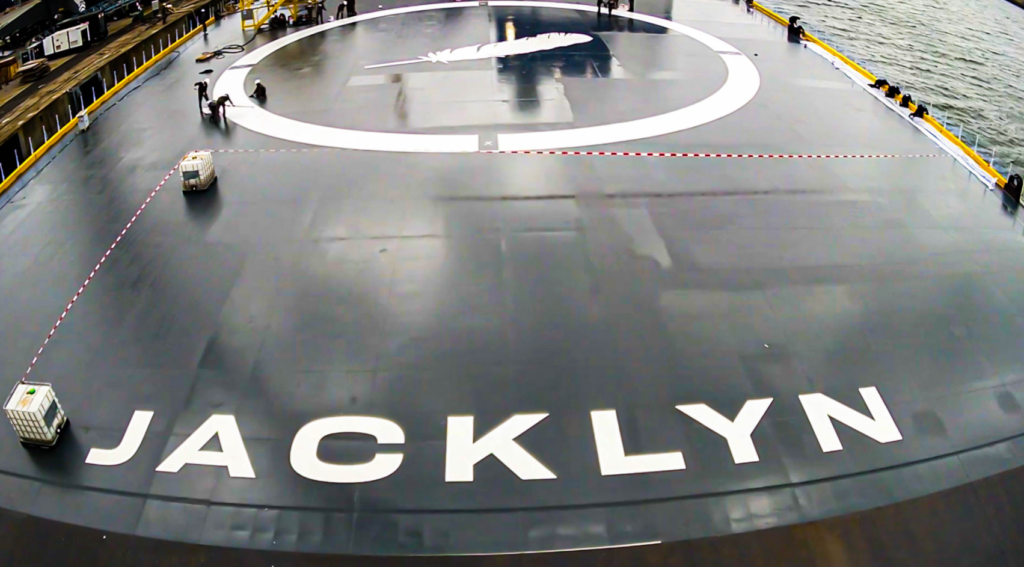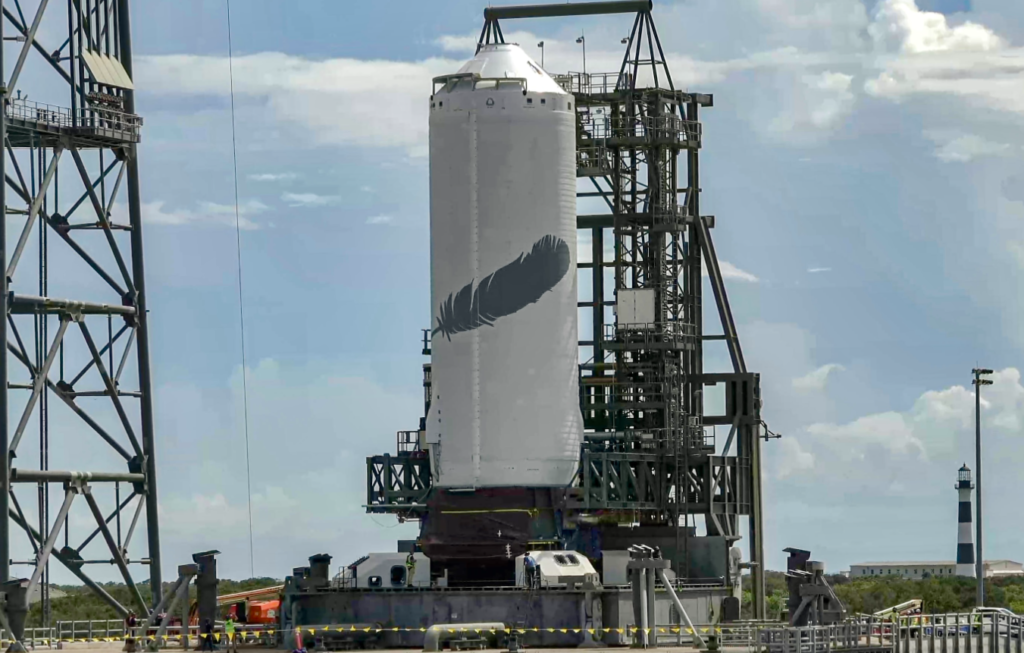As we get closer to the first launch of New Glenn, and with it, the first booster landing attempt, Blue Origin is continuing to prepare. Earlier this morning the company’s new landing barge arrived in Florida for the first time, docking not far from New Glenn’s launch site.
Originally, the plan was to use an actual ship with a massive landing platform in the center, that idea however was scrapped, along with the actual ship and they started working on a barge instead. By now it’s complete and just about ready for a massive booster to try and land on it. Here I will go more in-depth into its arrival, size, mission plan, and more.
Jacklyn Arrives

Originally, a few years ago in 2022, we heard that Blue Origin had begun work to contract out and build an autonomous landing platform for New Glenn. At the time the assumption was that the company would create something similar to SpaceX’s droneships with a few alterations. Since those first reports, the landing barge had been under construction over in Europe. Over the last week or so, it finally made the journey to Florida.
This morning Blue Origin tweeted saying, “Welcome home, Jacklyn. This sea-based landing platform is where New Glenn’s reusable booster will return home again and again after each mission to quickly refurbish for its next flight.” This included a short video of the barge in port both from onboard and also some aerial shots.
In terms of size, the barge is reported to measure 115m x 45m (377ft x 148ft). When compared to SpaceX’s drone ships, which are about 92m x 46m (302ft x 151ft), Blue Origin’s landing platform is bigger. Specifically, both platforms are about the exact same width, however New Glenn’s landing barge is about 20m longer.
In a different image provided by the company, it shows a closeup of the deck while crews are working. Here you can also see the name of the ship Jacklyn, which is named after Jeff Bezoz’s mother. With humans for scale, it really puts in perspective the size of the platform.
That being said, with the size of the New Glenn booster, they are going to need ample space. New Glenn’s booster measures around 58m in height with a diameter of 7m. When compared to SpaceX’s landing operations, New Glenn’s booster width is nearly double the Falcon 9 and almost 20m taller. With the landing legs out, New Glenn will take up a substantial portion of the barge and obviously require some serious accuracy.
Focusing back on the platform, the other obvious feature that stands out is the four large buildings, two on either side. As of right now, it’s not completely clear what these buildings will be used for relative to landing and transport operations. Some people assume they’re for a bunch of things from power generation to equipment storage, and even helping with the booster securment process after it lands.
Even with the launch set just over a month from now around October 13th, there still are a lot of unknowns related to New Glenn’s launch and landing operations. What we do know is that Blue Origin seems very confident in successfully landing the booster based on the fact they are trying it on the maiden flight.
SpaceX had plenty of failures before they were able to stick the landing and begin consistently reusing boosters. In Blue Origin’s case, if something were to go wrong during the landing, there is quite a bit of infrastructure that could easily be damaged. Ideally, everything goes well on launch day.
What’s interesting is that this landing barge was not the original plan. In 2018 Blue Origin bought a former roll-on/roll-off cargo ship to be transformed into New Glenn’s future sea landing platform. Over the next couple of years, up until 2022, the ship had been in port undergoing a refit. However, in August of 2022, Blue Origin abandoned its plans to use the ship as a landing platform, and the ship was towed to the Port of Brownsville for scrapping.
As far as Blue Origin’s reason, a company spokesperson said at the time, “Blue Origin is committed to safe and cost-effective access to space, and after careful consideration have made the decision to transition away from the Jacklyn as a landing solution.” In reality, based on the project and the few comments from the company, the design likely became a big concern regarding cost, complexity, schedule, and even the use of humans on the vessel which was debated by the company.
Specifically, Blue Origin had stated that the ship would not be crewed at the time the New Glenn booster was going to be landing; but rather would be autonomously or telerobotically controlled. All of which led to the decision to shift their focus to a landing barge.
When the rocket does finally launch, after second stage separation, the first stage booster reorients itself to reenter the atmosphere aft end first. Through a combination of aerodynamics and propulsive maneuvers, the stage performs a precision landing on the ocean-going platform in the Atlantic Ocean. After recovery at sea, the plan is to return the booster to the launch site via Port Canaveral for inspection and reuse. At the top of the stage are four fins. The four forward fins are actuated aerodynamic control surfaces used for attitude adjustment during descent and landing of the first stage. At the bottom, two wing-like strakes provide lift and cross-range for the reusable first stage as it flies back to Earth.
Upcoming Static Fire

As partially mentioned before, the maiden flight is scheduled to lift off soon, with an official launch timeline going from October 13th to 21st. With this, we’re hearing much more from the company as they prepare.
Yesterday for example they tweeted saying, “We’re looking forward to firing up those two BE-3Us on New Glenn’s second stage in a few days.” This included a few images of the stage making its way up to the pad for a static fire. This is the actual flight hardware and assuming things go well, will be stacked and on the pad in the near future.
These join a number of other comments from Blue Origin officials regarding some of the final work necessary. Last week Dave Limp, Blue Origin CEO was quoted saying, “Still lots to do but progress… A bunch of milestones coming up in quick succession (not an exhaustive list) – engine integration, our landing barge arriving soon, hotfiring second stage… And yes, lots of unique challenges as our first flight, but folks are excited and leaning in big-time” he said.
Already we can check a few things off this list like the landing barge arriving and almost the second stage hotfire. Even still, the company is now racing against the clock as the launch timeframe approaches. Blue Origin still needs to integrate 7 BE-4 engines, install the base heat shield panels, add two massive strakes, complete a wet dress rehearsal and static fire of the full rocket/booster, and integrate and encapsulate the two payloads.
The Escape and Plasma Acceleration and Dynamics Explorers (ESCAPADE) mission, has quite a strict launch timeline thanks to its destination being Mars. On this launch, the ESCAPADE mission will use two identical spacecraft to investigate how the solar wind interacts with the hybrid magnetosphere on Mars and how this interaction drives the planet’s atmospheric escape. The mission is funded by NASA’s Heliophysics Division and is part of the NASA Small Innovative Missions for Planetary Exploration program.
The reason these payloads are launching on New Glenn despite the timeline concerns and the fact that it will be the rocket’s maiden flight, is because it’s classified as a high-risk mission. NASA classifies it as a Class D mission which the agency describes as low priority and high risk. They also say that “Medium or significant risk of not achieving mission success is permitted. Minimal assurance standards are permitted.” This takes some pressure off Blue Origin as it’s not the end of the world if they miss the launch timeline however they seem adamant about launching on schedule.
Only about a week ago NASA tweeted, “NASA science onboard Rocket Lab’s twin spacecraft will liftoff from Space Launch Complex 36 for the inaugural launch of Blue Origin’s New Glenn rocket as part of the agency’s ESCAPADE mission, targeted for NET Oct. 13.” By now the two spacecraft have arrived and are just about ready for integration with the vehicle.
In order for the launch to happen next month, pretty much all testing has to go perfectly. A single setback is enough to miss the launch opportunity and force the company to instead launch New Glenn later without a payload. That’s part of the reason these upcoming static fires are so significant.
The engines on this stage are the BE-3Us, optimized to operate in the vacuum of space. With a back-to-back turbine assembly and a larger nozzle, BE-3U generates 160,000 lbf (712 kN) thrust in vacuum. The company is quoted saying, “Two BE-3U engines power New Glenn’s restartable upper stage, enabling the full range of customer missions including direct injection to geostationary orbit. Building on years of operational experience and rigorous testing, BE-3U will be one of the best-understood rocket engines when it launches into space” they said.
In only a few days we can expect to hear from Blue Origin regarding how the static fire went and what their next steps are. With just over a month until the launch date, there are going to be big milestones happening practically every week up until the flight. Something to look forward to as Blue Origin makes its final push toward New Glenn’s maiden launch.
Conclusion
Blue Origin’s landing platform has finally arrived and is just about ready for an actual landing attempt. At the same time, the company is prepping an upper-stage static fire in addition to a number of other milestones. If they’re fast and all the testing goes perfectly, they believe a launch next month is possible.
